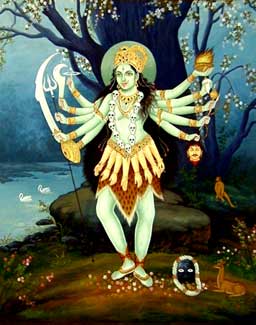
Neem Worship:
Myths vs. Realities for the Usefulness of Neem Oil
The tropical evergreen Neem Tree (Azadirachta indica) is a manifestation of the Mother Goddess Kali, shown in the top photo, or Durga, shown in the second photo. The tree is Herself a goddess called Neemari Devi. Neem is worshipped most intensely in southern India, where a few super-rich families control the production of neem oil.
The Neem-goddess Bhavani is shown in the third photo below, in a sculpture in New Delhi, with the heroic Prince Shivaji bowing before her. Yet another Neem-goddess is Mariamman, who weilds a neem leaf as though it were a sword which strikes out with wounds of disease. The fourth photo below is of a statue of Mariamman holding her neem-leaf sword & a cobra.
Tamil women who worship the Goddess Kali dress in red, carry branches of the Neem tree, & dance in public places swishing the branches as an act of exorcism & to purify the world. Throughout southern India neem trees are grown near Goddess temples, & Mahakali receives offering of neem leaves, or water to which tumerisk & neem have been added.
 The Bengalese Pat Gosain festival focuses extravagantly on worship of neem. Throughout Bengal, neem is the tree wherein Sitala dwells. She is the great Pox-mother who can cause or cure disease. Sitala is beseeched & given offerings underneath neem trees. The customary treatment of diseases is to rub the body with neem leaves while making prayers to Sitala. In the heat of summer, fans are made from neem leaves, to fan away Sitala's fever-demons that might otherwise bring about heat prostration.
The Bengalese Pat Gosain festival focuses extravagantly on worship of neem. Throughout Bengal, neem is the tree wherein Sitala dwells. She is the great Pox-mother who can cause or cure disease. Sitala is beseeched & given offerings underneath neem trees. The customary treatment of diseases is to rub the body with neem leaves while making prayers to Sitala. In the heat of summer, fans are made from neem leaves, to fan away Sitala's fever-demons that might otherwise bring about heat prostration.The multi-headed occult goddess Yellamma (also called Holiyyamma, Jogamma or Renuka Devi), worshipped primarily by the poor & illiterate, sometimes assumes the appearance of a young neem tree. During festivals to her honor, young maidens are made Yellamma's slaves, & clad themselves all over in neem branches so that they too look like Yellamma. Castrated priests also dress up as women & decorate themselves in neem leaves. This Neem-goddess is the central divinity in a nondescript little village with a small population, the village Saundatti or Soudathi in southern India. It can boast of little more than its 11th Century Yellamma fort-temple, but that's enough. During Yellamma's two key festivals, people arrive from all over southern & central India by the hundreds of thousands to honor her under a full moon.
As in the west where garlic was hung over doors & windows to keep vampires at bay, neem is even today hung on doors to keep evil spirits out, or placed in a room with a newborn baby to protect the infant from harmful spirits. Throughout life the child, then the adult, will incorporate neem into everyday life. The leaves are scattered on temple floors during wedding ceremonies. At death, neem branches are laid over the body in Kali's cremation grounds, the smoke of burning neem protecting both the living & the dead from evil spirits.
 Neem is regarded as a cure for sundry diseases on the same basis that it repels evil spirits, which is to say, on the level of faith, not scientific probability. It is thus hung on the doors of sick persons, or curative baths with neem leaves in the water, or powders & extracts or the leaves themselves taken internally. To be used properly, a specific holy festival day needs to be chosen, with specific rituals & prayers as prelude to the treatment, or it may not work.
Neem is regarded as a cure for sundry diseases on the same basis that it repels evil spirits, which is to say, on the level of faith, not scientific probability. It is thus hung on the doors of sick persons, or curative baths with neem leaves in the water, or powders & extracts or the leaves themselves taken internally. To be used properly, a specific holy festival day needs to be chosen, with specific rituals & prayers as prelude to the treatment, or it may not work.The goddess Maari comes sometimes in the guise of a serpent, sometimes as a neem tree, & can be a madly protective mother, or a barer of misfortunes. Because so many of the goddesses associated with neem are also associated with serpents, it is widely believed that neem has power over serpents, & is even regarded a cure for cobra venom. Or if one cooks with neem leaves or oil, the individual who ingests the magical becomes immune to snake venom. In objective scientific reality neem is not an antivenom. Its power over snakes, disease, bad luck, & ghosts is a religious power that does not apply to people who do not share the particular faith.
Because the Goddess is inherently erotic, neem oil is also used as a sexual lubricant, despite that for many it will be an irritant adding no great fun at all.
A key feature of neem worship is how the tree, or such goddesses as Sitala, Kali, & Miriamman, are simultaneously the cause & the cure of all sickness or bad luck. If neem more often than not fails to provide the cures & benefits alleged, this is because worshippers more often than not are unworthy, imperfect beings that we are. Failure of efficacy reflects on the user, not the cure. Such faith makes it nearly impossible to amend one's knowledge of what works & does not. All evidence to the contrary is dismissed as the fault of our own imperfect natures, but if we per chance recover, that was due wholly to one's trust & love for the Neem-goddess.
 Many of neem's magical & religious powers have been coopted by western herbalists & horticulturalists, religious beliefs becoming sales pitches. It is sold in the US marketplace as a dietary supplement without claims of medical value attached to the packaging, as it would be illegal to make medicinal claims; it is nevertheless bought as & used medicinally, for sundry illnesses it cannot actually treat.
Many of neem's magical & religious powers have been coopted by western herbalists & horticulturalists, religious beliefs becoming sales pitches. It is sold in the US marketplace as a dietary supplement without claims of medical value attached to the packaging, as it would be illegal to make medicinal claims; it is nevertheless bought as & used medicinally, for sundry illnesses it cannot actually treat.Love for neem trees in India is equivalent to a Christian's love of Jesus & as suchmerits the same respect as all religions. It is charming that people will grow a neem near their home & address Her sweetly as Nimmi, a veritable female family member as well loved as any daughter, & relied upon for assistance in times of struggle.
Westerners tend to fail to observe the essential rituals, prayers, & sacred days required for neem to become activated. Yet westerners' desire to believe in superstitions about plants is very great, with or without the added weight of religious sentiment & philosophy. I'm sure its much more liable to be of benifit to whoever is deeply devoted to Kali & uses Her tree together with songs of deep devotion. It cannot possibly have so strong a placebo effect on people who believe more generically in the magical healing properties of ground up garden rubble.
Love for the Mother Goddess, for trees that are sacred, for nature generally, is a wonderful thing. Delight in the sacred is at minimum akin to delight in poetry, & for the deeply devotional, it is much more. So long as it does not lead to warfare & prejudice against differing beliefs, Faith is something even the non-religious should be able to admit is often laudable, aesthetic, & admirable.
However, attempting to use Faith in lieu of Reason for practical purposes can be extremely harmful. When someone does not seek an actual antivenom for a cobra bite, because the victim's Faith insisted neem was all that was required, in that case Faith is apt to result in unnecessary tragedy. When poverty prohibits medical assistance for a life-threatening disease beyond a poultice of neem, that is both a social injustice & a family tragedy. Or when a gardener believing any old random claim promulgated under the semi-religious banner of "organic" uses neem for numerous alleged purposes for which it is not very useful, that's a smaller tragedy but still unfortunate for the garden.
So I set out to assess some of the purported practical uses of neem oil & other neem products, & tracked down some valid science which has tested these claims. My purpose was to sort out the scientifically valid from the mystical. All too often, it turned out that neem's magical ability to repel ghosts & evil spirits was also the basis for believing it will repel insects or agents of human sickness.
Neem oil is promoted to the west as an organic insecticide useful even against Japanese beetles, but the evidence is in the main to the contrary. Michigan State University & Cornell studies have indicated that Neem kills some beetle larvae that feed directly on a fully doused plant, but at the same time kills useful predator insects which feed on insects that have eaten from the drenched plant (including ladybug larvae). But it does not kill adult beetles (including ladybug adults). It marginally lowers beetle fertility rate (including ladybug fertility) so in the long run could lower overall beetle population (both harmful & beneficial types), if used often in drenching loads.
Even as a larvae-killer it has to get them at a delicate age & may require direct application with mostly a smothering effect, as with any horticultural oil, or even salad oil. As an insecticide per se it is at best mediocre. MSU stated that it repelled but did not kill beetles, whereas soapy water did kill beetles (though only if the soapy water were sprayed directly on the beetle), so as an insecticide, neem was less useful than a couple teaspoons of dishwashing liquid in a spraybottle of water. The MSU study also showed that neem oil's limited effectiveness as a repellant lasted for one or two days. It did not show any systemic protection as commonly alleged, though other studies do indicate a small systemic effect of lowered insect fertility.
It's stronger use is for certain kinds of troublesome funguses like black spot, as shown in a separate Cornell study. I wouldn't use it for mere powdery mildew because even sneezing on powdery mildew arrests it, & tests at Cornell, Davis, & in Brazil have shown a dilute milk spray both works better & is less likely to have unwanted side-effects, but for black-spot the milk spray didn't work & neem oil scored higher ratings. However, it was useful only as preventative soil-drench, binding fungal spoors to the ground so they do not spread to plants; it was not useful after-the-fact as direct application to plants. And regular soil drenches had a negative impact on the beneficial fungi which plants need to help them process nutrients.
Neem oil had not been thoroughly tested before it became popular in the west. It reached our marketplace chiefly because it cost pennies per drum from India but could be repackaged to sell dearly to Americans & Aussies for extravagant profits. "Two thousand years of use in India!" seems to have been "test" enough. The hornswoggling western vendors clearly understood, "Mother Goddess Empowered!" wasn't quite the right angle to convince westerners to believe in it, even though all claims of value were borrowed from the faithful of India.
A University of Washington study showed that Neem lowered the fertility rate of adult lady bugs (& other beneficial insects). By lowering the overall population of garden helpers, the organic balance of a garden is hampered, & harmful insects return to a garden more quickly than predator insects. This alone is sufficient to limit rather than extend its use of neem in garden.
The chemical component harmful to beetles beneficial & harmful is azadirachtin. When news got out that it harmed the ladybug population by lowering their fertility, Green Light neem oil removed azadirachtin from their product, effectively ending what little insecticidal value neem oil has. To restore that purported value, Green Light added pyrethrin to their neem brew to kill insects anyway, putting an end to itself as an organic product. All other brands of neem still contain azadirachtin.
While I don't think neem is ever going to be seriously indicted as particularly harmful, already most of its Magical Garden Benefits have been shown to be less effective than soapy water (for aphids or beetles) or milk spray (for powdery mildew). In the future other alleged super-uses will likely be shown in field tests to be only moderately effective or inferior to other organic choices. And even where it works, using gobs of it would not be healthful for a garden, though continued effectiveness could require reapplication as often as every 48 hours.
Recommendations to spray neem on plants themselves to control or eradicate blackspot & powdery mildew gums up the plant so that dirt adheres to it, harms the appearance of the plant, & does not eradicate the fungi. So as a fungicide, it is a bogus recommendation. It is only useful in "sealing" spores to the soil with soil drenches. This, too, can have harmful side effects, oil-drenched soil injuring the healthful population of topsoil microorganisms.
Soil-drench treatment for funguses was studied at Montana State University, & they found it to be apparently harmful to large ornamental shrubs, either from long-term absorption of repeat applications, or more likely due to destruction of beneficial funguses which are essential for tree & woody shrub health. They recommended using it only for small plants, plus warned the neem soil drenchings had little or no affect when used as a fungicide in alkaline soils.
As valid research diminishes the magical properties of Neem, gardeners are left to wonder how it became such a fad in the first place. The answer to that riddle is this: The benefits came to the west as rumors passed along by Neem worshippers.
The idea that neem should be used for all things at all times, as often as possible, never struck me as a good idea, but in India it is regarded as a super-spectacular idea, because the Neem tree as a manifestation of Durga or Kali, or a dwelling for Sitala, has all the authority of a religious idol or a prayer.
I see some people praising it like a wonder drug, & in many cases they are just seeing what they want to see, not what is provably the case. In Asia Minor it is used in the form of neem sticks to clean teethl; it is in Asian mouthwashes & toothpastes & facial creams; & in a great many entirely unproven herbal remedies recommended by herbal quacks in that unregulated industry. So a lot gets ingested without notable injury. But studies that seriously assess the possibility of injury are few & far between.
This was already a powerful industry, in the hands of an elite who are comparable to rubber barons, long before their economic power skyrocketed thanks to American & Australian gardeners' rather sudden & mainly unexpected delight in the stuff, & China's equally unexpected embracing of neem as an herbal remedy for internal use. Eastern studies are conducted without assessing possible risk, as the point is to extend the economic value of a popular resource, not to protect public health by finding out whether or not there are any negative side-effects to this wide base of neem exposures. Whle some therapeutic uses have already been disproven, they were not disproven by any of the India studies.
If you wanted to paint your naked body in red-dyed neem oil & hop around on a stage flapping your arms to some tune written by Satjit Ray, a love-song for Kali personified as a Neem Tree, you could get funding for it in India. If you wanted to test possibly harmful side effects with a serious double-blind study, you'd be out of luck.
There are "non profit" neem organizations throughout India that filter a combination of government & temple & industry monies to all kinds of projects just so long as they are oriented toward economic benefit & praise for the Sacred Neem. These non-profits are most often run by people with PhDs in theology or psychology who want to promote "global goodness of Neem" in the same way that Mormons go door to door at all points of the globe. Even when putting all sorts of doctoral names on studies, the only two purposes are Profits for the neem barons, & Worship for the Mother Goddess.
Australia is joining the research-for-profits crusade & generating careless research in support of a new neem industry there, but I expect there'll also be some serious research with some real findings out of Australia as there can't be out of India where the tree is Divine & above criticism.
Some of the extant studies (in India) are so biased for the industry they'll never tell you that while some skin-care values can be obtained with application of neem oil, they do not exceed the equally smelly value of fish oil, basil oil, or motor oil, or that neem has the higher risk of irritation so while potentially useful as a skin application, it is not so reliable as rubbing motor oil on one's face. So the "proven" value as a skin treatment is a statistical illusion built into research.
Another dubious study "proved" that neem oil kills mosquito larvae & lowers adult mosquito fertility. But the reality again is that salad oil shares much the same effect. The study compared egg-hatching & wriggler survival in water treated with two different preparations of neem & compared that to water untreated with anything. This is a basic India-style study the whole point of which is to help sell more Neem. It ultimately "proved" only that neem works better than doing nothing, yet the study is the basis of marketing neem willynilly for mosquito control, without assessment of possible environmental damage, cost-effectiveness, or effectiveness relative to other choices.
Because the neem tree is sacred to the Mother Goddess, magical & religious significance clouds clear judgment. Some of the studies resemble Christian "scientific" research on the efficacy of prayer; no one undertaking such studies in an attitude of devotional faith will ever see anything contrary to their faith. It is widely believed that whoever will eat neem leaves at the proper festival time will remain healthy until the age of one-hundred. When leaf-eaters die younger than that no one seems to notice the neem didn't work; but if one in ten thousand neem-eaters does live to see a century, that's all the proof anyone needs, because "Kali is great!"
On top of neem's religious significance is the economic juggernaut of neem agribusiness controlled by a very few very rich brahmanic families. While faith can be a grand thing, capitalist investment in faith is invariably a corruption of the kinder motivations of belief in beings higher than ourselves. Thus profiteers encourage belief in neem as an effective remedy for cancer, arthritis, diabetes, AIDS, heart disease, malaria & smallpox with many other allegations of magical benefit it does not possess. Ultimately no human illness exists which neem will not cure, according to the faith.
With this attitude deeply ingrained, it is impossible for broad knowledge of what neem might really be useful for to fully surface; the possible is buried under the greater welter of the impossible. Many learned Indians realize the absurdity of these claims, & neem is sometimes used almost as a synonym for quackery or craziness to describe crazy medicine, crazy reasoning, or crazy politics.
The "scientific" basis for these essentially religious claims for neem are invariably fudged in the plant's favor. Neem does have antibacterial qualities & would kill lots of terrible germs in a petrie dish that it could never ferret out of the human body. This mild antibacterial or antimicrobial activity is exaggerated all out of proportion by believers, with many patent neem-medicines having attached to them the most outrageous curative. Identical antibacterial claims could be made for mint, forsythia, salvia, sarcococca, pine tars, & a thousand other plants, all of which share with neem a complete uselessness in treating cancer, arthritis, AIDS, smallpox, & the other severe illnesses it is used for in the forms of fumigant, enema, suppository, tonic, or powder. This abuse of science to promote sales is key to the flimflam artistry of alternative medicine throughout the world, but honed to fantastic heights by religious neem profiteers because of its very sacredness.
One study alluded to by herb vendors "proved" neem was as effective as its chief rival, Ginkgo biloba. At least, that was the stated finding after the study was preposterously recast by herb vendors. The study actually showed that both Gingko biloba & Neem share an efficacy identical to that of placebo; neither is more effective than a placebo. But the advertisement version would have it that one worthless remedy is just as powerful as another useless remedy both of which are believed in by an enormous number of gullible customers.
While doing little to zero good, neem as medication apparently does equally little harm when used by hypochondriacs for vague or non-existent ailments. A few credible studies do support the probability that neem is in the main harmless to people & pets, if one overlooks that it is a common allergin. When rats were fed neem in controlled tests, it never reached a toxic level; the rats actually gained weight with neem in their diet. It has also a contraceptive effect on mammals (pets, livestock, & people) just as it does on some insects, but the a side-effect of human inability to reproduce can be regarded as beneficial to an overpopulated planet.
When organic gardeners use it, they should bear in mind its value is not of the highest measure; it is harmful to sensitive larvae of beneficial insects, harmful to beneficial fungus, & harmful to essential soil bacteria & microorganisms. Its use is not much more sensible than dumping Canola oil all over the plants & soil. Allergic responses to neem are a commonplace; & it is a potential hazard when it gets into wounds. It does share many of the same values as other horticultural oils, , but has no magical oomph that would justify paying more to get neem instead, & no additional values that justify using it for more purposes than would be the case for horticultural oils generally. And if a cobra bites you, for crine out loud get the actual antivenom, not the neem.